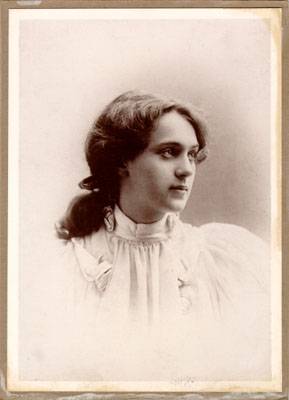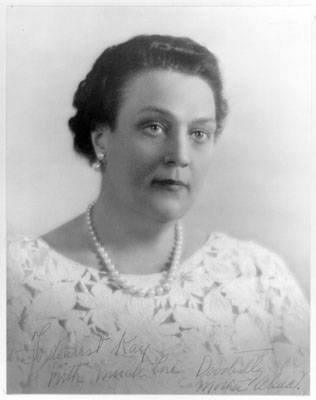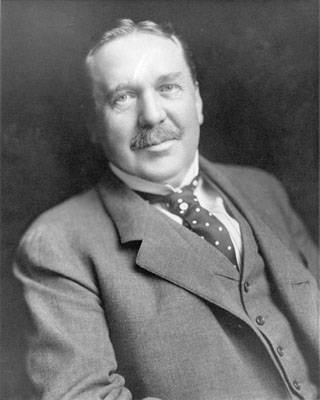Alma Spreckels
Spreckels [née de Bretteville], Alma Emma— Philanthropist, Socialite, and Patron of the Arts
Considered by many local historians to be the "great grandmother of San Francisco," the heiress to the fortune of sugar baron Adolph Spreckels was born Alma le Normand de Bretteville on a sandy farm in the city's Sunset District in 1881. Alma's parents, both Danish immigrants, struggled with near poverty during much of her early childhood.
Her father, Viggio de Bretteville, claimed a distant lineage to French aristocracy and delighted in telling his children of their "royal" heritage.
Alma Spreckels, c. 1903
Alma Spreckels, ca 1947
Photos: San Francisco History Center, San Francisco Public Library
He had a distaste for work in general and became embittered and jealous of San Francisco's nouveau riche, whom he viewed as commoners, undeserving of their Gold Rush wealth and privilege.
Alma's mother, Mathilde de Bretteville, had assumed the role of sole provider for the near impoverished family by the time Alma reached school age. Through her ingenuity and good business sense, Mathilde managed to move the family to a downtown flat on Francisco Street that the stoic matriarch converted into a combination Danish bakery, laundry service, and massage parlor.
At age 14, Alma was told by her father to quit school and work with her mother full-time, which she did, providing pickup and delivery laundry service to the palatial residences of the city's elite. She continued to read and educate herself, enjoying biographies of accomplished notables and the local society columns.
A fascination with fine art led her to enroll in night classes at the Mark Hopkins Art Institute, where she studied painting miniatures during her late teens. Her wholesome beauty began to make heads turn and she soon found herself working as an artist's model at the school, which paid for her lessons. Fed up with her meager financial situation, she accepted lucrative offers to pose in the nude for various local artists, who provided tastefully risqué paintings to the many saloons found along the city's infamous Cocktail Route.
With money to spend on stylish attire, and a growing local notoriety from her modeling ventures, Alma blossomed into a proper belle of San Francisco and attracted the affection of miner Charlie Anderson, whom she later successfully sued for "personal defloweration" in a breach of promise suit that made newspaper headlines. Local novelty became self-assured celebrity as Alma secured the position of model for sculptor Robert Aitken. His creation, a monument honoring naval hero Admiral Dewey and the recently assassinated president William McKinley, would feature the buxom temptress as a triumphant bronze libertine atop a granite pedestal, her right arm outstretched, holding the laurel wreath of peace towards the horizon, her left arm, raised above her head, valiantly pointing a trident to the heavens.
The memorial still stands today in the center of Union Square and is a recognizable backdrop in several notable films including Alfred Hitchcock's "The Birds" and Francis Coppola's "The Conversation." A huge hit on its unveiling in 1902, the towering tribute to the Republic was one of many entries to the Citizen's Committee in charge of the landmark's funding, and Aitken's work would not have been chosen had it not been for the crucial vote of the Committee's chairman, wealthy bachelor Adolph Spreckels.
Adolph Spreckels, 1908
Photo: San Francisco History Center, SF Public Library
Adoph was the loyal son of German-American industrialist Claus Spreckels, who had amassed a fortune growing a sugar production empire that virtually monopolized Hawaii and most of the western hemisphere. After Adolph was granted his initial introduction to "Miss Republic," the two courted seriously for five years. She learned much about the world and the refined culture of the Gilded Age through her well-traveled suitor, who was 22 years her senior.
It wasn't until 1908 that the sugar magnate, horse fancier, and yachtsman finally gave in to Alma's demands for marriage. The newlyweds moved into Adolph's Sausalito residence where Alma soon gave birth to a daughter, Alma Emma Spreckles, in 1909. Returning to San Francisco, Adolph purchased a temporary house on Vallejo Street, and as a Christmas present to Alma, he purchased the Jean Boyd house, located at the corner of Washington and Octavia Streets. The Victorian-style Boyd house, bought specifically for its breathtaking view of the San Francisco Bay and the Golden Gate, was torn down, and several nearby homes were purchased and physically moved down the street to make room for a new mansion designed by architects Kenneth MacDonald Jr. and George Applegarth. [1]
In 1911, Alma gave birth to a son, Adolph Bernard Jr., and the family's new massive Beaux Arts style mansion was completed in 1913. With the luxury of a staff of nannies and liveried servants, Alma began to focus her attention away from childrearing and towards the role of a proper high society hostess, not an easy feat, considering that most of San Francisco's power elite turned their noses up at the freethinking firebrand whose humble origins and association with "bohemian" artists caused controversy in an era of stifling Victorian mores.
Alma forged ahead however, and hosted several lavish parties at the opulent Pacific Heights residence. Although there were many local high society "no-shows," many city notables did attend, including writer Jack London, sculptor Earl Cummings, and 1906 Earthquake celebrity Dick Hotaling, whose whiskey warehouse was spared the flames of the devastating fire that followed, inspiring a popular poem of the day.[2]
Alma gave birth to her last child, Dorothy Constance, in 1913. Adolph's health soon began to deteriorate and Alma learned that her husband was suffering from progressed stages of syphilis. Luckily the disease had been in a latent, non-contagious stage during their years of physical intimacy, and had not been passed on to Alma or the children. Apparently Adolph knew he had the condition prior to their meeting and kept it from Alma, which explained his reluctance to marry her. Alma took the news in stride, and was relieved to end the sexual relationship with her husband, finding her hands more than full with her three children.
Intent on elevating the Spreckels name to a more prestigious level among the city's upper class, Alma set her sights on Europe, arriving in Paris in 1914. Originally planned as a shopping spree for 18th century furniture, Alma's adventure on the tumultuous continent on the brink of war was highlighted by an introduction to the vaudeville veteran and modern dance sensation Loie Fuller. World-renowned since her 1892 debut at the Folies-Bergere performing her notorious "Serpentine Dance," the Illinois-born "La Loie" was still the toast of Paris when Alma met her at a dinner party held at the exclusive Parisian restaurant, Ciro's. Alma became enthralled by the dance artist's colorful life and friendships with continental aristocracy, and Loie in turn felt great affection towards the wealthy American socialite who, with Loie's contacts and encouragement, would turn into one of the most important art collectors in America.
Through Loie, Alma met the pioneering sculptor Auguste Rodin, whose works made an indelible impression on the culture-hungry Alma, as well as on Loie Fuller, who had previously tried to promote Rodin's works in the US.
Alma returned to San Francisco just as World War I was breaking out in Europe, and she immediately set about acquiring several works by San Francisco sculptor Arthur Putnam, who would receive regular patronage from his new benefactor for the rest of his life.
Alma then recruited the assistance of Loie Fuller to purchase the Rodin bronzes, which she successfully accomplished through much persistence, eventually securing 13 of the masterworks for Alma, as well as some of the artist's drawings. Alma's beloved statues made their San Francisco premiere at the Panama Pacific International Exposition of 1915, where Alma, mesmerized by the beauty of the fair's French Pavilion, got the idea to build a museum of equal attractiveness, to permanently house her Rodin pieces and other objects d'art she had begun to acquire.
After the exposition, Alma dove into charity work, focusing nearly five years on rummage sales and high-society raffles to raise money for war-torn France and Belgium. Her five-limousine garage at 2080 Washington became a constant garage sale, and a much-publicized relief raffle at the Palace Hotel drew gift donations from US presidents and renowned figures in the arts and sciences. She even raffled off "The Genius of War," one of her most prized Rodins.
With some convincing, the reluctant Adolph agreed to fund Alma's museum project, which she envisioned not only as a cultural gift to the city, but also as a tribute to the 3,600 soldiers from California who were killed during World War One. She made a return trip to Europe, and secured financial support and art donations for her museum from the French government. She also met Loie Fuller's close friend, Queen Marie of Romania, who agreed to donate a replica of her Byzantine Golden Room.
Near the end of her trip, President Harding cabled Alma and asked her to go on a fact-finding mission about working conditions for women in post-war Europe for the US Labor Department's Women's Bureau. She obliged his request and returned to the United States with a well-documented and well-received report.
She then retained the services of her trusted architect George Applegarth to work on designing her new museum to be located in Lincoln Park. His design, a three-quarter scale-adaptation of the original Palace of the Legion of Honor in Paris, was accepted, and after five years of construction, the French neo-classical structure opened to much fanfare in 1924, with a grieving Alma presiding at the opening ceremony without her husband, who had died of pneumonia six months earlier. [3]
During the dedication of the California Palace of the Legion of Honor, on November 11, 1924, the Counsellor of the State of France, M.Albert Tirman, made a public announcement:
"The French government has not failed to acknowledge the worth and the moral significance of such a work. I am exceedingly pleased to inform you that the President of the French Republic has bestowed upon Mrs. Alma de Bretteville Spreckels the Cross of the Legion of Honor."
Adolph's death had been a devastating blow to the former laundry girl and artist's model, who now found herself one of the richest widows in the West. Alma had truly adored her husband, who was one of the select few in her ambitious life able to understand, appreciate, and adapt to her fiery nature and robust energy.
With the Jazz Age in full swing, Alma shrewdly liquidated some of her business holdings, notably the Oceanic Steamship Company and the San Diego Union and Tribune newspapers, and was able to enjoy the rest of the exciting decade in relatively unfettered excess. Throughout the mid-to late 1920s, Alma, and sometimes her children, moved between the Washington Street mansion, her late husband's newly remodeled ranch in Napa, California, the Ritz-Carlton in New York City, and a newly purchased summer chateau in Neuilly, France.
Somehow, amidst mood swings, screaming matches with her demanding children, and martinis and high-stakes poker games with the celebrity elite, Alma was able to balance her extravagant lifestyle and also keep sight of her philanthropic responsibilities.
She secured one million dollars and the extensive art collection of Harry and Millie Williams for her museum, funded San Francisco drama advocate Reginald Traver's "Little Theater Movement," and organized an exhibition at the Palace of the Legion of Honor featuring the works of more than 300 American sculptors.
As the Great Depression rolled in, Alma returned to the rummage sales and charity benefits she had spearheaded a decade and a half earlier. Her brainchild "salvage shops" for Depression relief, once sufficiently organized and funded, were later given over to the Salvation Army for administration. She also spent considerable time and money purchasing and redecorating Sobre Vista, her vast country estate in Sonoma, California, which provided a stable paycheck to an army of local construction workers during the desperate years of the early 1930s. It also proved to be a splendid environment for entertaining such celebrities as boxing champ Gene Tunney, San Francisco banker A. P Gianinni, and film stars Billie Burke, Bing Crosby, Mary Pickford, Douglas Fairbanks, Charlie Chaplin, and John Barrymore.
Other major expenditures at this time were a lavish coming-out party for her daughter Dorothy, which reportedly rivaled the extravagant debuts of both Barbara Hutton and Elsa Armour, and a generous financial donation to Maryhill Museum in Washington state.[4]
On a trip to Santa Barbara, Alma became intrigued by the exotic and costly Samarkand Hotel, a Persian-themed five-star money pit, which she later purchased and remodeled into a neo-classical repository for overflow from her expanding art collection. There, the 56-year old Alma was introduced to local Santa Barbara celebrity Elmer Awl, a successful manager for Armour ranches dubbed "Uncle Elmer" by the locals.
She fell in love with the 47-year old cowboy businessman who had co-founded the Rancheros Visitadores in 1929. Known for their annual chuck wagon camping trips, the Rancheros Visitadores became popular with the likes of Will Rogers and other Hollywood celebrities, and businessmen craving the smell of a horse and the nostalgia of the Old West.
In 1939, Alma married the flamboyant rancher she had found to be the life of the party. The two enjoyed a brief period of idle domestic bliss, but soon the restless Alma sent her new husband to Santa Barbara, to run the Samarkand Hotel for her and put his business skills to use while she attended to her activities in San Francisco. Eventually she realized that the Samarkand Hotel was not going to be the money-maker she envisioned, and sold the hotel and land at a loss. Elmer and Alma then resided briefly at Sobre Vista before the outbreak of World War Two, when Elmer was called to active duty in the Coast Guard reserves.
During the war years, Alma once again rose to the occasion and formed the San Francisco League for Servicemen, which provided musical instruments, sports equipment, toiletries, wheelchairs, and crucial hospital and medical supplies to the Army and Navy. She also converted her garage at 2080 Washington into a recycling center, and donated Sobre Vista to the Army as a recreational center. Towards the end of the war, Alma learned that Elmer had been having an affair with her niece and personal secretary, Ulla. Alma was granted a divorce in 1943 while Elmer was still stationed in Central America. Elmer and Ulla would later wed and settle in Santa Barbara.
Alma's next project involved extensive funding for the establishment of a maritime museum for the city of San Francisco. She had purchased a comprehensive collection of model ships assembled by maritime historian Edward S. Clark, founder of the Pacific Model Society, which were a popular exhibit at the Golden Gate International Exposition of 1939-40. The museum opened in 1951, with Alma's model ship collection exhibit as its core. In the late 1950s, Alma developed a feud with the museum's founding director Karl Kortum over who should be credited with the museum's founding. She was hurt over not receiving due credit for her funding or exhibit donations which had helped the fledgling museum get started.[5]
In 1961, Alma's son Adolph Jr. died of a heart attack, which upset her greatly. Her son had been a pleasure-seeker throughout his life, drinking to excess and persuing women, six of whom he had married and divorced. The violent-tempered Adolph never became the pillar of society Alma had hoped for, and perhaps she felt guilty for not being firm with him when he was a child. The later years of Alma's life were spent in near seclusion at 2080 Washington. She settled into a routine of morning nude swims in her backyard pool, mystery novels, and drives out to visit her two daughters, and especially her six grandchildren, who had all taken a fancy to the crusty eccentric.
Alma de Bretteville Spreckels died on August 7, 1968, of pneumonia. Her initial fortune of 14 million dollars had by the time of her death dwindled down to nearly 1 million, which she bequeathed to her grandchildren, with her two daughters receiving joint ownership of the mansion at 2080 Washington Street.
by Christopher Craig
Footnotes
[1] The Spreckels mansion at 2080 Washington Street is currently not open to the public and is the private residence of successful writer Danielle Steel.
[2] "If, as they say, God spanked this town For being much too frisky, Why did He burn His churches down And save Hotaling's Whiskey?"
[3] The California Palace of the Legion of Honor is located at Land's End in Lincoln Park and opened on Armistice Day, 1924. The museum houses more than 70 Rodin sculptures acquired by Alma Spreckels and later donated to the Legion of Honor. She also donated a large portion of her collection of French furniture, silver, ceramics, antiquities, and a large group of objects associated with the art of the dance.
[4] Maryhill Museum is located in Goldendale, Washington and was designed by architects Hornblower & Marshall as a private residence for wealthy entrepreneur Sam Hill. After his death in 1931, Alma Spreckels assumed responsibility for overseeing the completion of the museum which opened to the public on May 13, 1940.
[5] San Francisco Maritime Museum is located at the west end of Fisherman's Wharf and is part of the San Francisco Maritime National Historical Park, a unit of the National Park Service.
Bibliography
Scharlach, Bernice. Big Alma: San Francisco's Alma Spreckels Publisher: Scottwall Associates, 1995



